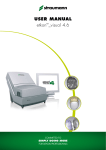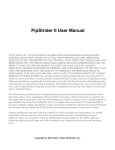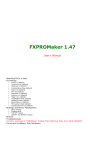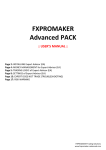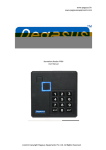Download Pegasus user manual - The Forex
Transcript
Pegasus high-yield automated investment software users manual The Forex-Assistant Research group, proudly introduces 'Pegasus' … and this horse can fly! Pegasus belongs to a new type of trading system referred to as Systemic trading which is mathematically based. It uses no indicators nor is it reliant upon news or proper timing. As of October 2013, it has been averaging around 3% per month. Pegasus is not considered a no loss system, as RISE and the PIG investment programs are, however it is still designed for investors albeit those with perhaps a little more appetite for risk in exchange for some higher profits. RISE and the Passive Income Generator are safer than just about everything available for investors today, but that added safety comes at a cost - they can only make just over 12% a year, while Pegasus is expected to double or even triple that return. While our other investment programs never closes a trade until it is in profit, Pegasus operates differently by accepting losses then making up for the loss on the next trade or iteration. The best known loss recovery technique is a martingale recovery. Briefly, a simple martingale system would accept a loss then double the size of the last trade that was lost and go again, this is kept up until a win or you're out of money which is labeled a margin call. If we started with the smallest size trade allowed on the forex market we would have a series of trades that would begin 0.01 lots, however to simplify the concept we will start with 1 lot. The sequence would then be 1, 2, 4, 8, 16, 32, 64, 128 representing eight iterations. For our purposes here, an iteration is just a trade that is in a series of trades. If we lost eight times in a row, we would be down by the sum of all those losses which is the equivalent of one trade for 255 lots or 2.55 if we had started with .01 lots. However, if we win on any one of these iterations, we win just .01 lots which is what we started with. Though there are modified martingale systems that do a lot better job of return, there is still a problem with the traditional system which is that the size of the trade grows too quickly and can make the standard martingale unfeasible. Another recovery sequence is called a Fibonacci sequence. To get the next number in the sequence we add together the two previous sizes together. Again we will start with .01 but modify it just a bit. Once again we will be using whole numbers to aid with clarity. The first trade of 1 lot is added to the Pegasus Manual © 2013 Bob LLewellyn / The Forex-Assistant previous trade size of zero to get 1 again. Then the next size is 2 as the first 2 trades of 1 lot and 1 lot is added together. Here is the modification, we start with the second 1 lot trade so our sequence goes 1, 2, 3, 5, 8, 13, 21, 34, 55, 89. That sequence is for ten iterations and still has a smaller final lot size and total losses of 144 than the martingale sequence. The difference is that a martingale will recover the previous losses with the same number of pips as the previous loss. In other words, if our losses came from a range size of 10 pips, the martingale would recover in just 10 pips. The Fibonacci sequence requires us to hold the trade open a little longer, but it also has some other properties that make it work so effectively. But how much longer we need to keep our trade open is limited and tends to equal out at 1.62 times the original size. To help us see the significance of why this is so, it may help to note that if we divide the value of any of the Fibonacci iteration by the previous number in the series that number gets closer and closer to 1.62 which is also close to PHI the number of nature itself. We won't go into PHI here but it is worth looking up because it has so much to do with our existence on this planet. The chart below is basally what Pegasus uses for its trading. Iteration Fibonacci Losses Range Number of Pips for recover Value Per iteration Multiplier 10 Pip range 20 Pip range 1 1 1 1.00 10 20.0 2 2 2 1.00 10 20.0 3 3 4 1.34 13.4 26.8 4 5 7 1.40 14.0 28.0 5 8 12 1.50 15.0 30.0 6 13 20 1.54 15.4 30.8 7 21 33 1.58 15.8 31.6 8 34 54 1.59 15.9 31.8 9 55 88 1.60 16.0 32.0 10 89 143 1.61 16.1 32.2 11 144 232 1.62 16.2 32.4 12 233 376 1.62 16.2 32.4 13 377 609 1.62 16.2 32.4 14 610 986 1.62 16.2 32.4 15 987 1596 1.62 16.2 32.4 ---------------------------------------------------------------------------------------------Once again we are using whole numbers in the chart above for simplicity's sake, just multiply the whole number by the size of your first trade such as .01 lots to get the actual trading size. The first column is labeled iterations and is how many attempts you have made to get a profitable trade but failed. The second column is the associated Fibonacci value for the number of iterations. This multiplier times the size of the first trade is the size of the current trade. For example, the Fibonacci value for the 4th iteration is 5, so if our first trade was .01 lots then our fourth trade would be for five times that amount or 0.05 lots. Pegasus Manual © 2013 Bob LLewellyn / The Forex-Assistant The third column represents the expected losses up to the point. Notice that the first trade already has a loss of 1, remember the modification that we referred to earlier by starting with the second 1, the first 1 is a pretend loss and placed in the basket that needs recovered. This assures us that our profit is included at the end of the trade and that we are making a profit for each time the price goes in the right direction. You can see that each loss level is the previous losses plus the Fibonacci value for that current level. For example, on the fourth iteration we have 7 in our loss column, that is the accumulated losses of 1 + 2 + 3 plus the one for profit that we started with. If we lose that 4th iteration then we would add the Fibonacci value for the forth level which is 5 to show a loss of 12 on the fifth level. To determine our range size multiplier we divide the losses up to that point by the Fibonacci value for that level. For the fourth iteration that would be a loss of seven divided by the Fibonacci value of five to get the amplifier rate of 7/5 =1.40 Every time we lose a trade, that loss is for the size of the trade times the size of the range. If the range size is 10 pips and our first trade is .01 lots then our first loss will be for $1.00 because every pip is worth 10 cents per each .01 lot trade size. If our range size is 20 pips then each range equivalent would be for $2.00 From this we can calculate how many pips we would need to fully recover the accumulated losses including the first one that we never had but included as our profit. Using our range multiplier for the 4th iteration we can see that if the price moves 14 pips in the right direction for a starting range of 10, or 28 pips for a starting range of 20 pips, we would fully recover from the previous losses plus make a small profit depending on the range size. Every time we get the direction right and make a profit, we start over at our base trade size. To decide which to use a buy or a sale, we use what we know about the tendency of the price to head for the center of the total trading range, we continue to use the split grid system, that is buying when the price is closer to the historical low and selling when the price is closer to the historic high. The natural question that everyone asks is what happens if the price only moves in the wrong direction for a long time or jumps? If we are using a 20 pip range and a maximum of 10 iterations then the price would have to move over 200 pips to have a reset and place Pegasus into recovery mode. If that happens then Pegasus would begin doubling the size of the trades until the total losses are made up. By doubling the trade size we continue to make our normal profit through half of our trade while the other half compensates for the losses. After the recovery has been completed, Pegasus returns to normal trading by reverting to the normal trade size. This is the settings box: This is designed to be as simple as possible to make it easy for almost anyone to use the more profitable trading system without actually being a professional trader. A side note here, if there is a word or name that we are using that is unfamiliar to you, you can find out more from the research website that goes with our type of trading: http://forex-assistant.com Whenever you want to know more, we got you covered. Pegasus Manual © 2013 Bob LLewellyn / The Forex-Assistant AllowTrading is defaulted to true, and it has to be set to true in order for the program to work. It is like a shut off switch. Pegasus requires you to do some things, instead of it being completely automated. This is done to keep the system as simple as possible so there are fewer things to not work. KISS (Keep It Strictly Simple). CrossOver is one of the settings that you are required to set. The CrossOver is the point where we shift from buys to sells. Every trade below that point is a buy and every trade above that point is a sell. Look at the currency pair that you are using on the monthly time display and find a place somewhere around the center between the Historical Highs and Historical Lows. Remember that most currency pairs charge a daily interest called swap on sells so you might want to shift your CrossOver point a little higher so there are more buys and fewer sells. For example I use 1.3000 on the EURUSD where the actual center would be closer to 1.2100. If you were to set the CrossOver at the top of the trading range like 2.0000 then you will only have buys, if you were to set it at zero then you would only have sells. Neither one of these extremes are a good idea as large jumps in price happen most often when the price is far away from center and heading back toward it. RangeSize is the number of pips from where the the trade opens to where it closes for a loss. The higher the number of pips the safer your trading will tend to be, but also with lower risk comes lower profits. Somewhere around 20 to 25 pips seems to balance the combination of safety and profits. MaxIter is the maximum number of iterations (or losses) before resetting the Fibonacci sequence back to one and starting to double all trade sizes until a full recovery has been accomplished. A MaxIter of 10 to 12 seems to work well. I use 10 as I would prefer to keep my recovery times short. Fixiterations would usually be left at zero as that allows the Fibonacci progression to occur, but from time to time the investor/trader may feel the need to force a certain trade size as apposed to allowing the computer to select it. If that happens, place the actual size of the trade in the field for the fixed Pegasus Manual © 2013 Bob LLewellyn / The Forex-Assistant iteration but remember to replace it after the trade has been opened or every trade after that, whether for a profit or loss will be for that same size. BalFact is short for the balance factor and that is a way to determine how large to make your first trade. Pegasus calculates the amount required to trade starting with .01 lots and going to whatever the MaxIter is set for. It prints the required amount on the chart off to the left with other comments. By dividing the actual balance by the required amount, Pegasus can determine the size of the trade. If you would rather have a higher amount as the requirement, all you have to do is to put the preferred requirement in the field for the BalFact. You can use the BalFact to adjust for an account being opened in another currency other than the first one listed on the currency pair. For example, we can calculate the required amount by looking at the chart above. If we use a MaxIter of 10 then our losses would be what we would show for our collective losses on the eleventh iteration. From the chart above that would be 232 times the loss from our first trade. Assuming our first trade was for .01 lots and the range size was 20 pips, then at 10 cents a pip, each range would pay or take 2 euros. Remember that all amounts are calculated in the first listed currency. For the EUR/USD that would be euros. However, if I opened my account in US dollars then I would need to adjust for the currency difference. So my requirements are for three times the loss for level 11, (the next one after max) which is 232 and multiply that times the expected profit/loss of 2 Euro for a subtotal of 1392 Euro and add the margin requirement for two times the Fibonacci value at the max iteration of 10 which is 89 times the amount required for .01 lots which at 200:1 is 5 Euro or a margin requirement of 890 Euro. 890 plus the trading requirement of 1392 Euro is 2282 Euro. At the current exchange price we would need to use a balance factor 1.36 times the 2282 or 3103.52 US. We round up to the next 500 so we would set our BalFact to 3500. Now for every $3500 in our balance Pegasus will add .01 lots to our first trade. reset_recovery is how we can adjust the recovery balance. On the cut-a-way on the left we can see that the recoverybal = 0. This means that Pegasus isn't in recovery mode and all trades are of normal size. Leaving the reset_recovery to zero allows the computer to set the recoverybal as is required. Any other amount in the reset_recovery will place that amount to be recovered. Reset_Basket is the amount that needs to be recovered by the Fibonacci recovery system. By placing any amount in this field other than zero, will force that amount in the basket. Let's say that you close a trade early and it doesn't quite compensate for the losses, you Pegasus Manual © 2013 Bob LLewellyn / The Forex-Assistant can use the fixIteration to set the trade size and use the reset_basket to make up for the losses. Most of the time you will not need to use the Reset_Basket, the reset_recovery or the FixIteration and will let them set to their default of zero. Today is October 17, 2013 the day that the government was to hit the debt limit again, and we saw a large quick price increase and the eur/usd climbed over 180 pips without reversing by at least 32 pips. Each trade size or range size is 20 pips, and from the cut-a-way above we can see that we are on the 9th iteration with a Fibonacci value of 55. The multiplier of 2 comes from the balance factor and we are starting our trades out at .02 lots. The multiplier of 2 times the Fibonacci level of 55 times the base trade size of .01 lots, means that our current LotSize is 1.1 lots as seen on the chart. It also displays the maxIteration at 10 then it fails to tell us how much we are required to have at a minimum to cover the trades through the 10th iteration(max). The reason is that it recalculates when it takes a new trade and I disrupted the program and it has not taken a new trade since I disrupted it. Right now it shows a requirement of 1 which means it will adjust for the next trade. Nine iterations has been the largest number that we have seen occurring naturally, (we have never seen an actual reset for Pegasus.) After the line that tell us that Pegasus is running in production mode, we can see that to compensate for the 348 Euro in the basket to be recovered we need to have the price move down by 31.8 pips from where the trade was opened. When it does that, all the losses carried in the basket plus our profit will be realized, and Pegasus will start over at .02 lots. You can see that the demonstration account has a margin leverage of 500:1 which means that I have to set aside $2.00 for each .01 lots in open trade. Us citizens that don't have an off shore account have to reserve 420 for each .01 lots, because the largest margin leverage allowed in the US is 50:1. That hurts American traders and it is mandated by the US government. They just don't like us very well do they? For added safety and to cover any small unexpected expenses*, we recommend that you open your account with at least $500 more than required for the chosen MaxIteration. Using our defaults from above we would open with $4,000 and set our BalFact at 3500. * an example of a small unexpected expense: if you happen to be in a sale in one of the higher iterations on a Wednesday when the swap is three times the normal daily rate You can learn how to set up a MetaTrader4 brokers interface program and how to place your Pegasus program on it by going to forex-assistant.com and reading about your particular topic of interest. For now we would like to thank you for using our automated investment program (Pegasus) and we continue to wish you all of the very best in your retirement years ahead. Pegasus manual © 2013 The Forex-Assistant / Bob Llewellyn (all rights reserved) Pegasus Manual © 2013 Bob LLewellyn / The Forex-Assistant U.S. Government Required Disclaimer Trading foreign exchange on margin carries a high level of risk, and may not be suitable for all investors. The high degree of leverage can work against you as well as for you. Before deciding to invest in foreign exchange you should carefully consider your investment objectives, level of experience, and risk appetite. The possibility exists that you could sustain a loss of some or all of your initial investment and therefore you should not invest money that you cannot afford to lose. You should be aware of all the risks associated with foreign exchange trading, and seek advice from an independent financial advisor if you have any doubts. The purchase, sale or advice regarding a currency can only be performed by a licensed Broker/Dealer. Neither we nor any of our affiliates or associates involved in the production and maintenance of these products or this site, is a registered Broker/Dealer or Investment Advisor in any State or Federally-sanctioned jurisdiction. All purchasers of products referenced at this site are encouraged to consult with a licensed representative of their choice regarding any particular trade or trading strategy. No representation is being made that any account will or is likely to achieve profits or losses similar to those discussed on this website. The past performance of any trading system or methodology is not necessarily indicative of future results. Clearly understand this: Information contained in this product are not an invitation to trade any specific investments. Trading requires risking money in pursuit of future gain. That is your decision. Do not risk any money you cannot afford to lose. This document does not take into account your own individual financial and personal circumstances. It is intended for educational purposes only and NOT as individual investment advice. Do not act on this without advice from your investment professional, who will verify what is suitable for your particular needs & circumstances. Failure to seek detailed professional personally tailored advice prior to acting could lead to you acting contrary to your own best interests & could lead to losses of capital. *cftc rule 4.41 – hypothetical or simulated performance results have certain limitations. Unlike an actual performance record, simulated results do not represent actual trading. Also, since the trades have not been executed, the results may have under-or-over compensated for the impact, if any, of certain market factors, such as lack of liquidity. Simulated trading programs in general are also subject to the fact that they are designed with the benefit of hindsight. No representation is being made that any account will or is likely to achieve profit or losses similar to those shown. Additional important notice for US citizens: U.S. Government regulations restrict U.S. Citizens from fully utilizing the services of foreign brokers. It is ill-advised for U.S. Citizens to violate the laws of their country. However, there are legal ways to regain your freedom to trade effectively. To find out how, read on … The most obvious one is to set up an off shore trust or IBC (International Business Corp.) There are several benefits to establishing an IBC/ trust. One such benefit is the ease in passing the trust and its assets on to your heirs without probate. Another reason this is done all the time is to protect assets from frivolous law suits, it adds an extra layer of safety because if someone sued you for the asset in that trust or own by a corporation, he would have to do so in the country of residency for that trust/IBC. Additionally, an attorney may not be so quick to take a case against you if you personally have very little assets, because most of your assets are in an off shore trust or belong to a business. A trust can also have its own bank account, foreign trusts wouldn’t come under the same limitations for its investing as it is not a U.S. Citizen and U.S. law would be inapplicable. Your retirement program is a natural part of a normal trust. In Belize owner information is protected by law. Drawbacks are one, it cost around $1,700 to start one. The yearly fees are close to $800, but the first year is included in the setup cost. There is another option, at this time we can’t recommend it. There are still a number of unregulated brokers that will take your money, sometimes literally. We are told that since the broker is from some other area, they are not bound by U.S. law. We are told that the U.S. law is worded to limit brokers and there is no law prohibiting U.S. citizens from opening an off shore broker account, (if they can find a broker willing to take them). But are these unregulated brokers are breaking U.S. law by accepting U.S. clients? Could this jeopardize your account? Now it may not come to that, but traders are risk managers and I don’t see the rewards out weighing the risks here when there are alternatives. It may seem hard being singled out and treated like the property of the government but these are hard times and yet, you do have friends. Our concern here is not as much for what is true at the present, but what may become true in the near future. If you are a US citizen you may consider checking out the Passive Investment Generator which works well with US brokers however, the NFA has forced changes to the trading rules twice in so many years, there is no reason to believe that they won’t do it again. This should not be taken as legal advice, only as a suggestion from friends. Pegasus Manual © 2013 Bob LLewellyn / The Forex-Assistant








